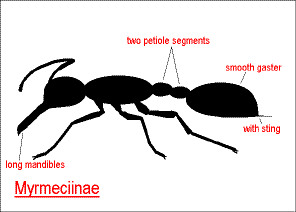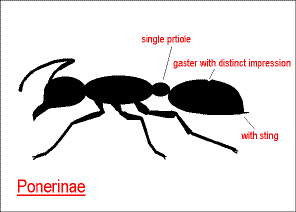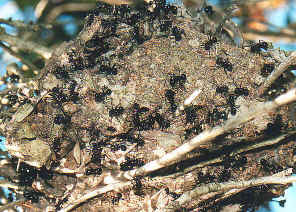Ants - FAMILY FORMICIDAE
This page contains pictures and information about ants that we found in the Brisbane area, Queensland, Australia.

All ants are in family Formicidae and all of them have a waist. Their waist is composed of one or two knobs which are the first one or two segments of their abdomen. Their antennae have a distinct elbow. Ants live in colonies made up of several castes. These included the winged male, winged female and wingless workers.
Ants are social insects; they form small to large colonies. Ant colonies usually contain: an egg-laying queen and many workers together with their brood i.e., eggs, larvae and pupae. Worker ants carry out different jobs including nest construction, foraging, looking after the brood and queen, and nest defense.
When the ant colony becomes mature, the next generation of winged queens and males are produced. They are present in the nest for only a short period. Soon after emerging, they leave the nest to mate and establish new nests elsewhere.
Queens usually look similar to the workers but have larger bodies. Males are about the same size as the workers or smaller, with smaller heads, larger ocelli and smaller mandibles. Males may look more like wasps than ants.
Most ants will attack their enemy. Some ants have powerful
stings. Others eject vapors of formic acid.
Ants Subfamily
- Many ants species can easily be found in Brisbane. There are 16 ant subfamilies world-wide. We have 10 of these in Australia. Of these 10 subfamilies, five are very common and can easily be found in most areas. Followings are the links that listed what we found.
Myrmeciinae - Bulldog Ants, Jumper Ants
- The mesosoma is attached to the gaster by two distinct segments, the petiole and postpetiole . The mandibles are very long and straight, with teeth along their inner margin. There is the sting at the tip of their gaster.






Ponerinae - Pony Ants
- The mesosoma is attached to the gaster with a single segment. The gaster usually has a distinct impression between the first and second segments. There is the sting at the tip of their gaster.
-


Myrmicinae - Myrmicine ants
- For the Myrmicines ants the mesosoma is attached to the gaster by two distinct segments. There is the sting at the tip of their gaster.
-




Dolichoderinae - Meat Ants, Tyrant Ants
- The petiole is a single segment. The gaster is smooth and does not have constrictions between the segments. The tip of the gaster is absent of sting, and is slit-like, without a circular opening.





Formicinae - Spiny Ants, Sugar Ants
- For the Formicinae ants the petiole is a single segment. The gaster is smooth and does not have constrictions between the segments. The tip of the gaster is absent of a sting.
-








- Reference and Link:
- 1. Australian Ants Online - S.O. Shattuck and N.J. Barnett, CSIRO 2001.
- 2. Common names of northern Australian ants - CSIRO Tropical Ecosystems Research Centre, 24 May, 2005.
- 3. Common names for Australian ants (Hymenoptera: Formicidae) - Alan N Andersen, Australian Journal of Entomology (2002) 41 , 285–293.
- 4. Australian Ant Image Database - Australian Ant Image Database, R.W Taylor.
- 5. myrmecos.net - myrmecos.net, Alex Wild, 2005.




